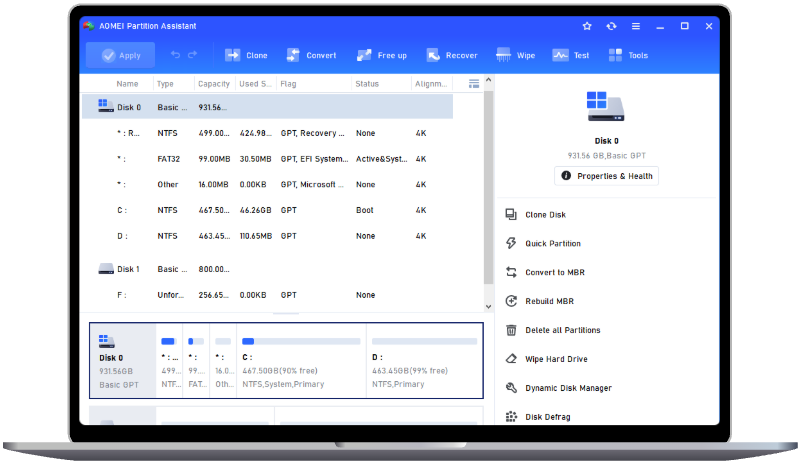[Fixed]: What Happens When You Format a Filesystem on a Partition?
Formatting a filesystem on a partition is a common task that many users encounter when setting up new storage devices, reinstalling an operating system, or resolving issues with an existing drive. But what happens when you format a filesystem on a partition? And how can you do it easily? This post will explain the details and guide you through the process of formatting a partition file system.
What Happens When You Format a Filesystem on a Partition?
What does formatting a partition do? It is actually the act of creating a file system on a volume so that the operating system can store and retrieve data on that partition. But what happens when you format a filesystem on a partition? Here are several key processes that occur:
Erasing All Data: When you format a filesystem on a partition, all existing data on the partition will be deleted. Therefore, it is advised to back up essential data before processing.
Creating a New File System: Whether you choose NTFS, FAT32, or another file system, the formatting process sets up the necessary structures for the operating system to store and retrieve files.
Preparing the Partition for New Data: Once the partition is formatted, it is ready to store new data in an organized and efficient manner.
How to Format a Partition File System with Ease?
After knowing "what happens when you format a filesystem on a partition", let’s move on to how to do that. Formatting a partition file system can be done in several ways, depending on your operating system and the tools you have available. Below are three common methods to format a partition file system. To avoid unexpected errors, always ensure you have backups before proceeding.
Method 1: Using Windows Disk Management
Windows Disk Management is a built-in tool that allows you to manage your disks and partitions. It’s a straightforward method for formatting partitions on a Windows system. Here’s how to format a partition file system via Disk Management:
Step 1: Right-click on “This PC” on your desktop and select “Manage”.
Step 2: In the popup window, select “Disk Management” under “Storage” on the left side.
Step 3: Right-click on the partition you want to format and select "Format."
Step 4: Choose the file system and allocation unit size.
Step 5: Click "OK" to start the formatting process. Once the formatting is complete, the partition will be ready for use with the new file system.
Method 2: Using DiskPart
If you would rather use a command line to format the drive, DiskPart would be the first choice. This method is powerful and allows for precise control over the formatting process. Here’s how to format a partition using Diskpart:
Step 1: Click Start, type "cmd", right-click it, and select "Run as Administrator"
Step 2: Type the following commands and press Enter after each one:
- list disk (List all disks on the system.)
- select disk X (Replace X with the disk number.)
- list partition (List all partitions on the selected disk.)
- select partition Y (Replace Y with the number of the partition that you want to format.)
- format fs=exfat (Select file system for the partition.)
- assign letter=Z (Assign a drive letter to the formatted partition.)
Step 3: Once the process is complete, type "exit" and press Enter to close the Command Prompt.
Method 3: Using Professional Third-Party Software
If you're looking for a more versatile and user-friendly way to format a drive, you can use a third-party tool like AOMEI Partition Assistant. This disk management software is compatible with Windows 11, 10, 8.1, 8, and 7, making it a great alternative to built-in tools like Disk Management. It supports a wide range of file systems, including FAT32, NTFS, Ext2, Ext3, Ext4, and exFAT, allowing you to format not only your PC's internal drives but also external hard drives.
Here’s how to format a partition file system using AOMEI Partition Assistant:
Step 1: Download AOMEI Partition Assistant and install it on your computer.
Step 2: Launch this software, right-click the partition you want to format, and select "Format Partition".
Step 3: In the pop-up window, reset the partition label, file system, and cluster size as needed. Then click "OK" to proceed.
Step 4: You can preview the operation. If everything looks correct, click “Apply” and “Proceed” to perform it.
In addition to formatting, AOMEI Partition Assistant offers a variety of practical features to help you manage your drives more effectively, including convert NTFS to FAT32 without formatting, resizing partitions, allocating free disk space, and more.
Summary
In this post, we’ve explored the key aspects of what happens when you format a filesystem on a partition and provided detailed guidance on how to format a partition file system. If you are looking for an easy and effective way, AOMEI Partition Assistant is highly recommended. By following the steps outlined above, you can effortlessly manage your drives and ensure they are properly formatted for optimal performance.
FAQs
Q1: Can I recover data after formatting a partition?
In some cases, data can be recovered after formatting, especially if a quick format was performed. However, it’s not guaranteed, and specialized software may be required. If you want to erase all data to protect privacy, consider using the “Wipe Partition” feature within AOMEI Partition Assistant.
Q2: What is the difference between a quick format and a full format?
A quick format only erases the file system structures and does not check for bad sectors. A full format, on the other hand, checks for bad sectors and takes longer to complete.
Q3: Which file system should I choose when formatting a partition?
It totally depends on your needs. NTFS is commonly used for Windows, ext4 for Linux, FAT32 for smaller drives, and exFAT is a good choice for cross-platform compatibility.


